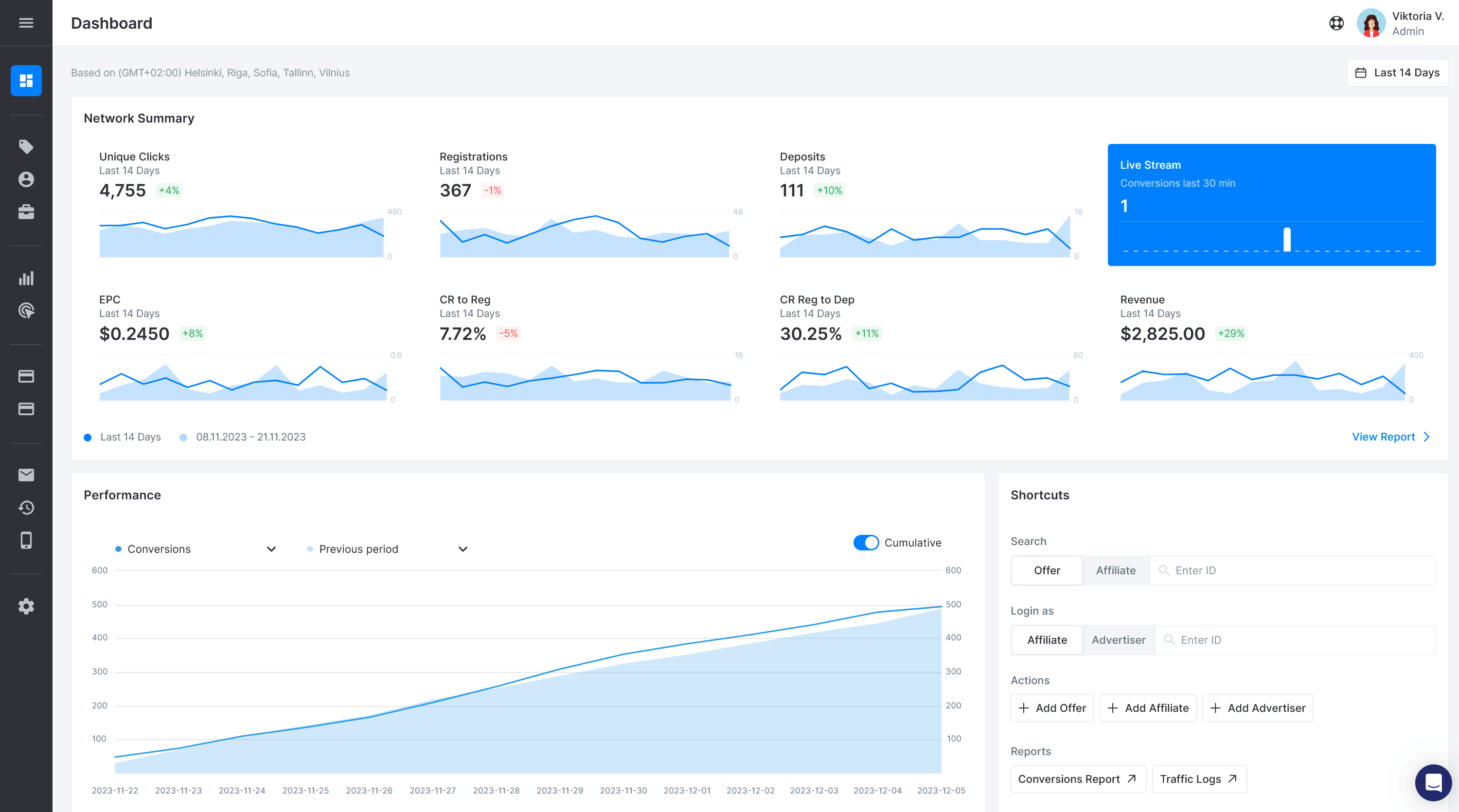Do you ever wonder how successful affiliate marketers find clarity in their campaigns? With the vast amounts of data that they must sift through, it seems impossible. However, visualizing data insights is the key to finding valuable information and driving strategies.
Did you know that 90% of the information transmitted to our brain is visual? Our brains are wired to process visual information faster than any other data type. So, if you want to understand how your affiliate marketing performance affects your business truly, it’s important to visualize your data.

You can communicate complex data effectively using this technique and use it as a tool.
Let’s show you how!
Understanding the Importance of Data Visualization in Affiliate Marketing
Data visualization allows marketers to present complex data in a simple, visually engaging way. This makes it easier for diverse audiences to understand and interpret the information. Marketers can quickly identify performance patterns and easily exploit them.
They can then make well-informed decisions based on those patterns, ultimately optimizing their campaign.
Enhancing Comprehension for Diverse Audiences
The main reason why visualized data works so well in affiliate marketing is its ability to enhance comprehension for diverse audiences. Instead of presenting raw data on spreadsheets or text-heavy reports, charts, graphs, and other types of media can be utilized instead. These have been proven more effective at making complex issues easier to understand.
Quick Identification of Performance Patterns and Anomalies
Real-time visualization helps marketers quickly identify patterns and anomalies within their campaign efforts.By analyzing this kind of data regularly, marketers can easily spot trends that aren’t immediately apparent when looking at numbers alone.
Tools to Communicate Complex Data Effectively
Communicating complex data has always been a struggle in marketing disciplines across all industries. However, visualization provides us with a range of tools that we can utilize when delivering our message. By using interactive charts, dashboards, and infographics, marketers can simplify the data sets and present them in a visually appealing way.
| Visualization Tool | Description |
|---|---|
| Charts and Graphs | Visual representations of data that help to illustrate trends, comparisons, and relationships. |
| Interactive Dashboards | User-friendly platforms that allow marketers to explore data, filter information, and gain valuable insights. |
| Infographics | Visual representations that combine data, text, and design elements to present complex information concisely and engagingly. |
Selecting the Right Data Visualization Software – Scaleo
When it comes to affiliate marketing, choosing the right software for visualizing your data is crucial. One popular option on the market is Scaleo. This powerful software offers many features and benefits that are useful for presenting your affiliate marketing data.
Scaleo is praised for its user-friendly interface.

Marketers at any skill level can easily navigate and use its features. One feature is the ability to visualize your affiliate marketing data, and then apply insights to campaigns so you get better results.
One perk of using Scaleo is the ability to generate in-depth reports and dashboards. These reports provide detailed snapshots of your affiliate marketing performance, with key metrics and trends included for tracking purposes. The visualizations are simple to understand, letting you digest complicated data fast.
Another nifty feature of Scaleo is the customizable reporting options. You can tailor these reports to suit your specific needs and preferences. This means selecting only important metrics that will help drive success within your campaign.
There’s also advanced filtering and segmentation features built into this tool. Data can be broken down by traffic sources, geolocation, device type, etc… By doing so, you can gain deeper insights into how well your affiliate marketing performance has been.
As far as integrations go, Scaleo works smoothly with other tools commonly used in affiliate marketing. So whether you want it linked to an email program or CRM system, it’ll work without a hitch.
In conclusion when it comes time to pick out the right data visualization software for affiliate marketing tasks… It’s hard not to choose Scaleo. With this software on your side, you get all-in-one solutions that are easy to use and integrate with other programs seamlessly, too.
When visualizing data related to your affiliate marketing goals there’s a few things you need:
- A clear narrative
- Appropriate visualization types
- Engaging color schemes and design principles
Starting off strong by defining the narrative for your goals is what will keep audiences engaged throughout their experience viewing your visual data efforts.
To do this, consider objectives first, along with metrics (and insights) that are most relevant to those goals specifically.
The next step involves choosing which visualization types to use. It’s important to pick ones that align with your narrative and are suitable for conveying the data insights you want to present.
Finally it all comes down to engaging color schemes and design principles. Be sure to select visualizations that look appealing, as this can be a big reason why someone decides to engage with (or ignore) your content in the first place.
Effective and visually stunning visualizations can be created by using color schemes and design principles. Choose eye-catching colors that enhance the overall look of your data. To emphasize important points, consider contrasting colors. Never forget to incorporate design principles like simplicity, consistency, and proper labeling of data for clear visualization that’s easy to understand.
Crafting Your Visual Data Storytelling Strategy
When it comes to visualizing your data insights, you have to find the perfect balance between making them look good and being functional. Presenting information in an attractive and user-friendly way enhances comprehension, allowing companies to make informed decisions for success in affiliate marketing.
Defining the Narrative for Your Affiliate Marketing Goals
To start, you need to determine the story you want to tell with your visual data. This includes identifying the key objectives, metrics, and insights that are most relevant to your affiliate marketing goals. By defining a clear narrative, you can guide your audience through the data in a way that highlights the most important information and supports your overall marketing strategy.
Aesthetics vs. Functionality
When presenting data insights, there should always be a balance between aesthetics and functionality. You want your visuals to appeal to viewers and give them a positive perception of what you’re showing them. However, don’t let the design choices compromise the purpose of why you’re presenting the information at all. The visuals must support their purpose and allow users to easily analyze the information given.
Clarity Reduces Misinterpretation
Minimizing misinterpretation starts with having a clear way of presenting data. When people can see through clear labels and annotations, they’ll know exactly how they should be interpreting the information given in context with everything else displayed on screen.
Affiliate Branding for Cohesive Visuals
Alignment is key when creating any visual representation of your brand or message. In this case, aligning design elements with the branding of your affiliate will create a strong sense of identity within visuals that are meant convey insights – while also telling audiences who you are without even needing words.
Visualizing Data Insights with Effective Design Principles
To effectively visualize data insights, it is crucial to employ effective design principles that balance aesthetics and functionality. By presenting data in a visually appealing and user-friendly way, marketers can enhance comprehension and make informed decisions that drive affiliate marketing success.
Balance Between Aesthetics and Functionality
When visualizing data insights, striking a balance between aesthetics and functionality is essential. Aesthetically pleasing visualizations capture viewers’ attention and create a positive perception of the data being presented.
However, it is equally important to ensure that the design choices do not compromise the visualization’s functionality. This means that the visual elements should support the purpose of the data representation and enable viewers to interpret and analyze the information easily.
| Data visualization principle | Description |
|---|---|
| Consistency | Ensuring a consistent design language and style across different visualizations |
| Simplicity | Presenting data in a simple and easy-to-understand manner without unnecessary clutter |
| Hierarchy | Organizing data elements in a logical and hierarchical structure to convey meaning |
| Interactivity | Providing interactive features that allow viewers to explore and interact with the data |
Learning from Real-World Data Visualization Examples in Marketing
In marketing, data visualization is where complex information meets easily understandable visuals. By looking at real-world examples, you’ll be able to pick up on trends and gain insight into how you can effectively visualize data for your affiliate marketing campaigns.
Real-world examples show the different ways you can use data to grab attention and communicate important insights. It’s one thing to know why something works, and another to see it happen.
One great example is the unique way Coca-Cola decided to execute its data visualization in its 2014 “Share a Coke” campaign.

What they did was create personalized Coke bottles with individual names and, through the use of some groundbreaking techniques, displayed the most popular names on their website. To boot, this interactive visualization allowed users to not only search for their own name, but see how popular different names were as well. This drove engagement and generated tons of buzz.
Another impressive feat was Spotify’s annual “Spotify Wrapped” campaign. Essentially what they did is take each user’s listening habits throughout the year and turned them into personalized infographics. Showing people what songs, genres and artists they listened too the most that year. By doing this Spotify encouraged sharing across social media platforms and created a sense of connection among its users.
Airbnb is also a big player in the game when it comes to visualizing data effectively in marketing. They showcase their accommodations’ availability and pricing through interactive maps and charts that are always updated in real time. By doing so users can make informed decisions about where they want to stay on their trip before even booking anything. Airbnb uses these visualizations to build credibility with its users while enhancing their experience.
These examples prove just how successful these strategies can be when put into play properly by designers or marketers alike. There’s much insight one can take away from these examples when studying them closely such as different approaches to design, techniques used, tools used etc.
| Real-World Data Visualization Example | Brand | Key Takeaway |
|---|---|---|
| Coca-Cola’s “Share a Coke” campaign | Coca-Cola | Showcases the power of personalized data visualization in driving engagement and generating buzz. |
| Spotify’s “Spotify Wrapped” campaign | Spotify | Illustrates the use of personalized data visualization to foster a sense of connection and community among users. |
| Airbnb’s interactive maps and charts | Airbnb | Highlights the importance of visualizing real-time data to provide transparency and enhance the user experience. |
Marketers can take their data visualization strategies to the next level by analyzing these examples and extracting valuable insights. With the right combination of design principles, data storytelling, and tools, they can effectively visualize data for affiliate marketing, captivate their audience, and drive meaningful results.
Interpreting Data Visually: Tools and Best Practices for Affiliates
In the world of affiliate marketing, interpreting data visually is crucial for gaining valuable insights that can drive informed decision-making. By effectively visualizing data, affiliates can uncover patterns, identify areas for improvement, and optimize their marketing strategies. In this section, we will explore some essential tools and best practices that can help affiliates interpret and communicate data through visualizations.
Implementing Interactive Dashboard Features
An interactive dashboard is a powerful tool that allows affiliates to explore and analyze their marketing data dynamically and flexibly. With interactive features such as filtering, drill-down capabilities, and real-time updates, affiliates can delve deeper into their data and uncover hidden trends or performance outliers. By customizing the dashboard to display key metrics and KPIs, affiliates can quickly assess the effectiveness of their campaigns and make data-driven decisions.
Using Annotations and Legends for Enhanced Clarity
Annotations and legends are essential elements in data visualizations that provide additional context and clarity. Annotations can highlight specific data points or events, providing valuable insights and explanations. Conversely, legends help users understand the meaning or color coding of different elements in the visualization. By utilizing annotations and legends effectively, affiliates can ensure that their visualizations are easily understood by their audience, leading to better communication and decision-making.
Establishing a Feedback Loop for Ongoing Improvements
The process of visualizing and interpreting data is not a one-and-done. It’s an ongoing cycle that needs to be improved as time goes on. Gathering feedback from stakeholders like clients, team members, or industry experts can give you the insight you need to make meaningful improvements.
Using iterative improvements helps you stay aligned with your goals. This ensures that the right metrics are being addressed and providing useful insights along the way. Regularly seeking feedback and making changes when necessary will help in interpreting data more effectively.
Leveraging interactive dashboard features, using annotations and legends effectively, and establishing a feedback loop are all key tools to improve data interpretation. They’ll help you quickly gain insights, optimize campaigns, and ultimately gain a competitive edge in affiliate marketing.
Conclusion
Visualizing data insights is essential for making better decisions in affiliate marketing. It offers clarity and gives you actionable insights into your performance patterns.
Choosing the right software can give you a huge advantage with your visualization process. By defining your narrative first, then choosing your visualization types based on that story will lead to engaging visuals. Remember to use design principles that don’t sacrifice aesthetics for functionality, though.
By implementing these best practices into your work ethic, you can interpret and communicate data more effectively with others. This alone will make it easier for everyone else involved to understand what’s going on at every step of the way




